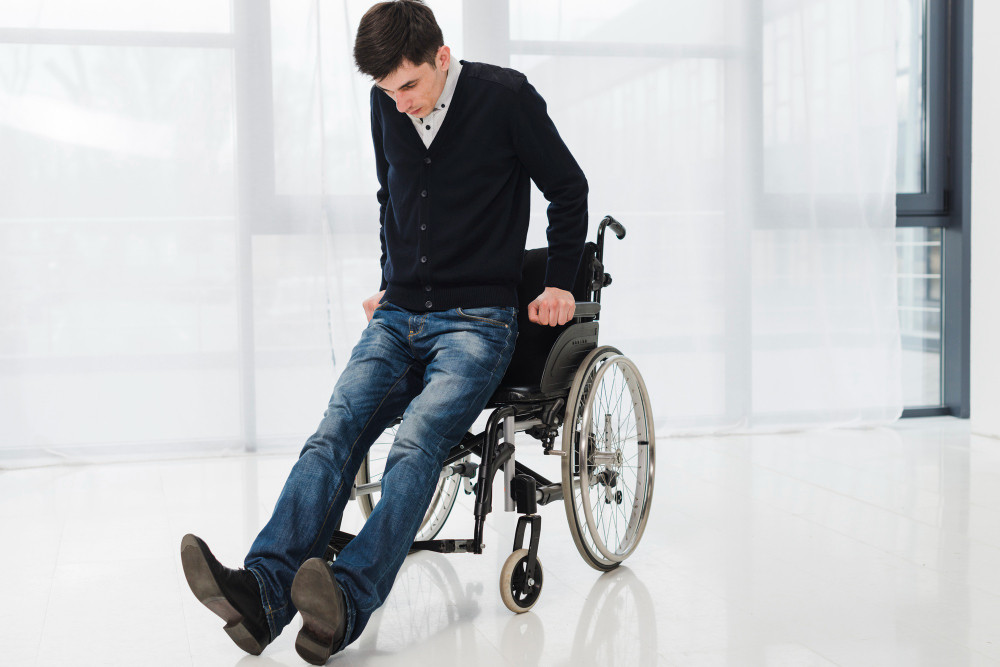
Paralysis, referred to as Pakshaghata (affecting one half of the body – hemiplegia), Ekanga Vata (affecting a single limb), or Sarvanga Vata (affecting the whole body – quadriplegia) in Ayurveda, is predominantly considered a Vata Dosha imbalance. Vata, being the dosha responsible for all movements, sensory functions, and nerve impulses, is primarily vitiated. While Vata is the main culprit, Pitta and Kapha can also be involved, influencing the specific symptoms and prognosis.
The underlying causes in Ayurveda often include:
- Vata aggravation: Due to various factors like trauma, excessive exertion, suppression of natural urges, improper diet and lifestyle, or degenerative changes.
- Dhatu Kshaya (Tissue Degeneration): Particularly of Majja Dhatu (nervous tissue) and Mamsa Dhatu (muscle tissue).
- Srotorodha (Channel Blockage): Leading to impaired circulation and nutrient supply to affected areas, often due to Ama (toxins) or Kapha.
Ayurvedic treatment for paralysis is highly comprehensive and individualized, focusing on:
- Pacifying aggravated Vata Dosha.
- Nourishing and strengthening the nervous system (Majja Dhatu).
- Rejuvenating muscles and improving their strength (Mamsa Dhatu).
- Improving circulation and clearing blocked channels.
- Eliminating Ama (toxins).
- Restoring sensory and motor functions.
- Enhancing overall physical and mental well-being.
Here’s a detailed overview of Ayurvedic treatment approaches for paralysis:
I. Shodhana (Panchakarma – Detoxification and Purification Therapies): Panchakarma therapies are the cornerstone of Ayurvedic treatment for neurological disorders like paralysis, aiming for deep cleansing and rejuvenation. The choice and sequence of therapies depend on the patient’s condition, dosha predominance, and strength.
- Abhyanga (Therapeutic Oil Massage):
- Description: Full-body or localized massage with warm, Vata-pacifying medicated oils.
- Oils Used: Dhanwantaram Taila, Ksheerabala Taila, Bala Ashwagandha Taila, Mahamasha Taila, Karpasasthyadi Taila, Mahanarayana Taila.
- Benefits: Deeply nourishes nerve and muscle tissues, improves blood circulation, reduces stiffness, muscle spasms, and pain, strengthens muscles, and calms the aggravated Vata. It prepares the body for further therapies.
- Swedana (Fomentation/Steam Therapy):
- Description: After Abhyanga, various forms of medicated steam or fomentation are applied.
- Types Used: Njavara Kizhi / Shashtika Pinda Sweda (fomentation with boluses of specially cooked Njavara rice in milk and herbal decoction), Patra Pinda Sweda (poultice with medicinal leaves), Kizhi (herbal poultice fomentation), Bashpa Sweda (medicated steam chamber).
- Benefits: Induces sweating, opens channels, reduces stiffness, pain, and spasticity, helps in liquefying Ama, and improves absorption of medicinal oils. Njavara Kizhi is particularly nourishing and rejuvenating for muscles and nerves.
- Basti (Medicated Enema):
- Description: Considered the most effective treatment for Vata disorders, as the colon is the primary seat of Vata. Medicated oils (Sneha Basti) or herbal decoctions (Kashaya Basti) are administered rectally.
- Benefits: Directly pacifies systemic Vata, strengthens the nervous system, nourishes tissues, and helps in the elimination of toxins. Specific Bastis like Raja Yapana Basti or Valuka Sweda Basti are used.
- Nasya (Nasal Administration):
- Description: Instillation of medicated oils or ghritas (ghee) into the nostrils.
- Oils/Ghritas Used: Anu Taila, Ksheerabala Taila, Brahmi Ghrita, Vacha Ghrita.
- Benefits: Directly affects the head and brain, nourishes the brain and nerve tissues, improves sensory and motor functions (especially beneficial for facial paralysis – Ardita), and helps clear channels in the head.
- Shirodhara:
- Description: Continuous, gentle pouring of warm medicated oil, milk, or buttermilk over the forehead.
- Benefits: Profoundly calms the nervous system, reduces stress, anxiety, and mental fatigue. It helps to improve brain function and mental clarity, which is important for patient cooperation in rehabilitation.
- Pizhichil (Oil Bath/Oil Squeeze):
- Description: A continuous stream of warm medicated oil is poured over the entire body, often accompanied by gentle massage.
- Benefits: Highly rejuvenating and nourishing, especially for Vata disorders. It improves muscle tone, nerve function, and overall vitality, reducing muscle wasting and weakness.
- Udwartana (Dry Powder Massage):
- Description: A vigorous massage with dry herbal powders.
- Benefits: While primarily for obesity, specific Udwartana can be used in cases of paralysis with associated Kapha accumulation or sluggishness to stimulate circulation and reduce heaviness.
II. Shamana (Palliative Therapies & Herbal Medicines): These involve internal medications to support nerve regeneration, muscle strength, and overall recovery.
- Herbs for Nerve and Muscle Support (Vata-pacifying & Rejuvenating):
- Ashwagandha (Withania somnifera): A powerful adaptogen and nervine tonic. It helps reduce stress, strengthen the nervous system, improve muscle strength, and reduce inflammation.
- Bala (Sida cordifolia): “Strength” herb, strengthens muscles and nerves, reduces stiffness, and promotes mobility.
- Guduchi (Tinospora cordifolia): Immunomodulator, detoxifier, anti-inflammatory, and rejuvenative.
- Rasna (Pluchea lanceolata): Anti-inflammatory, analgesic, and Vata-pacifying, beneficial for joint and muscle pain.
- Punarnava (Boerhavia diffusa): Diuretic, anti-inflammatory, helps reduce edema if present.
- Dashamoola: A blend of ten roots, widely used for Vata disorders, pain, and inflammation.
- Shankhpushpi (Convolvulus pluricaulis) & Brahmi (Bacopa monnieri): Brain tonics that help with cognitive function and mental well-being, which can be affected in paralysis.
- Garlic (Lashuna): Vata-pacifying, improves circulation, and has nervine properties.
- Classical Formulations:
- Brihat Vata Chintamani Rasa, Vata Gajankusha Rasa, Ekangaveera Rasa: Complex herbo-mineral formulations used for severe Vata disorders and paralysis (to be taken under strict medical supervision due to metal content).
- Maharasnadi Kashayam, Dashamoolarishta, Dhanwantaram Kwath: Decoctions used for Vata disorders, pain, and neurological conditions.
- Yogaraja Guggulu, Mahayogaraja Guggulu: Anti-inflammatory and pain-relieving, beneficial for joint and muscle issues.
- Ksheerabala 101 Avarthi, Dhanwantaram 101 Avarthi: Highly potent medicated oils prepared multiple times, used internally for severe neurological conditions.
- Chyawanprash: A powerful rejuvenative and immune booster, supports overall health and strength.